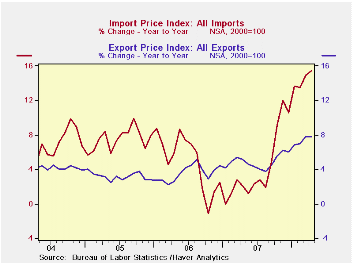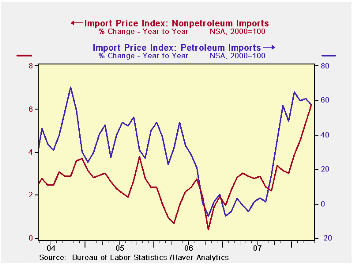 Global| May 13 2008
Global| May 13 2008U.S. Total Import Prices Surged, Ex. Oil They Jumped As Well
by:Tom Moeller
|in:Economy in Brief
Summary
Overall import prices surged last month. The 1.8% gain was right in line with expectations and it followed an even stronger 2.9% surge during March. Together the increases were the strongest on record. Petroleum prices jumped 4.4% [...]

Overall import prices surged last month. The 1.8% gain was right in line with expectations and it followed an even stronger 2.9% surge during March. Together the increases were the strongest on record.
Petroleum prices jumped 4.4% after the 9.2% surge during March. Imported crude petroleum prices already are up another 10% this month versus April.
Less petroleum, import prices increased 1.1%, the same as during March. These increases were the largest on record, pushed higher by the lower foreign exchange value of the dollar.During the last ten years there has been a 66% (negative) correlation between the nominal trade-weighted exchange value of the US dollar vs. major currencies and the y/y change in non oil import prices. The correlation is a reduced 47% against a broader basket of currencies.
Excluding petroleum, prices for industrial supplies & materials surged another 3.3% (17.0% y/y) which was the same as the spike during March. These prices are up 11.7% year to date due to strength in finished metal, chemicals and agricultural prices. The detailed import price series can be found in the Haver USINT database. 
Capital goods import prices rose 0.8% (2.1% y/y) last month but less the lower prices of computers, capital goods prices rose 1.1% (4.4% y/y), the fastest rate of annual gain since 1995. Prices of computers, peripherals and accessories fell 0.3% (-3.8% y/y).
Finally, prices for nonauto consumer goods imports rose 0.2% (2.8% y/y) after two months of 0.4% increase. The y/y increase was the quickest since 1992. Price gains were notably strong for apparel and household goods.
The increase in total export prices eased to just 0.3% after three consecutive months of increase above 1.0%. Agricultural prices fell 2.2% (+32.3% y/y) but nonagricultural export prices rose 0.6% (5.6% y/y).
Globalization and Monetary Policy is today's speech by Cleveland Fed Bank President Sandra Pianalto and it can be found here.
| Import/Export Prices (NSA) | April | March | Y/Y | 2007 | 2006 | 2005 |
|---|---|---|---|---|---|---|
| Import - All Commodities | 1.8% | 2.9% | 15.4% | 4.2% | 4.9% | 7.5% |
| Petroleum | 4.4% | 9.2% | 57.2% | 11.6% | 20.6% | 37.6% |
| Non-petroleum | 1.1% | 1.1% | 6.2% | 2.7% | 1.7% | 2.7% |
| Export- All Commodities | 0.3% | 1.5% | 7.7% | 4.9% | 3.6% | 3.2% |
Tom Moeller
AuthorMore in Author Profile »Prior to joining Haver Analytics in 2000, Mr. Moeller worked as the Economist at Chancellor Capital Management from 1985 to 1999. There, he developed comprehensive economic forecasts and interpreted economic data for equity and fixed income portfolio managers. Also at Chancellor, Mr. Moeller worked as an equity analyst and was responsible for researching and rating companies in the economically sensitive automobile and housing industries for investment in Chancellor’s equity portfolio. Prior to joining Chancellor, Mr. Moeller was an Economist at Citibank from 1979 to 1984. He also analyzed pricing behavior in the metals industry for the Council on Wage and Price Stability in Washington, D.C. In 1999, Mr. Moeller received the award for most accurate forecast from the Forecasters' Club of New York. From 1990 to 1992 he was President of the New York Association for Business Economists. Mr. Moeller earned an M.B.A. in Finance from Fordham University, where he graduated in 1987. He holds a Bachelor of Arts in Economics from George Washington University.






